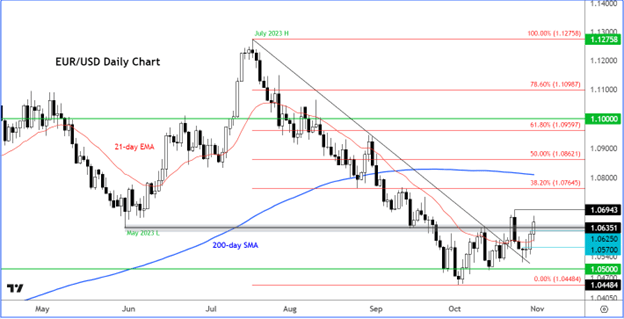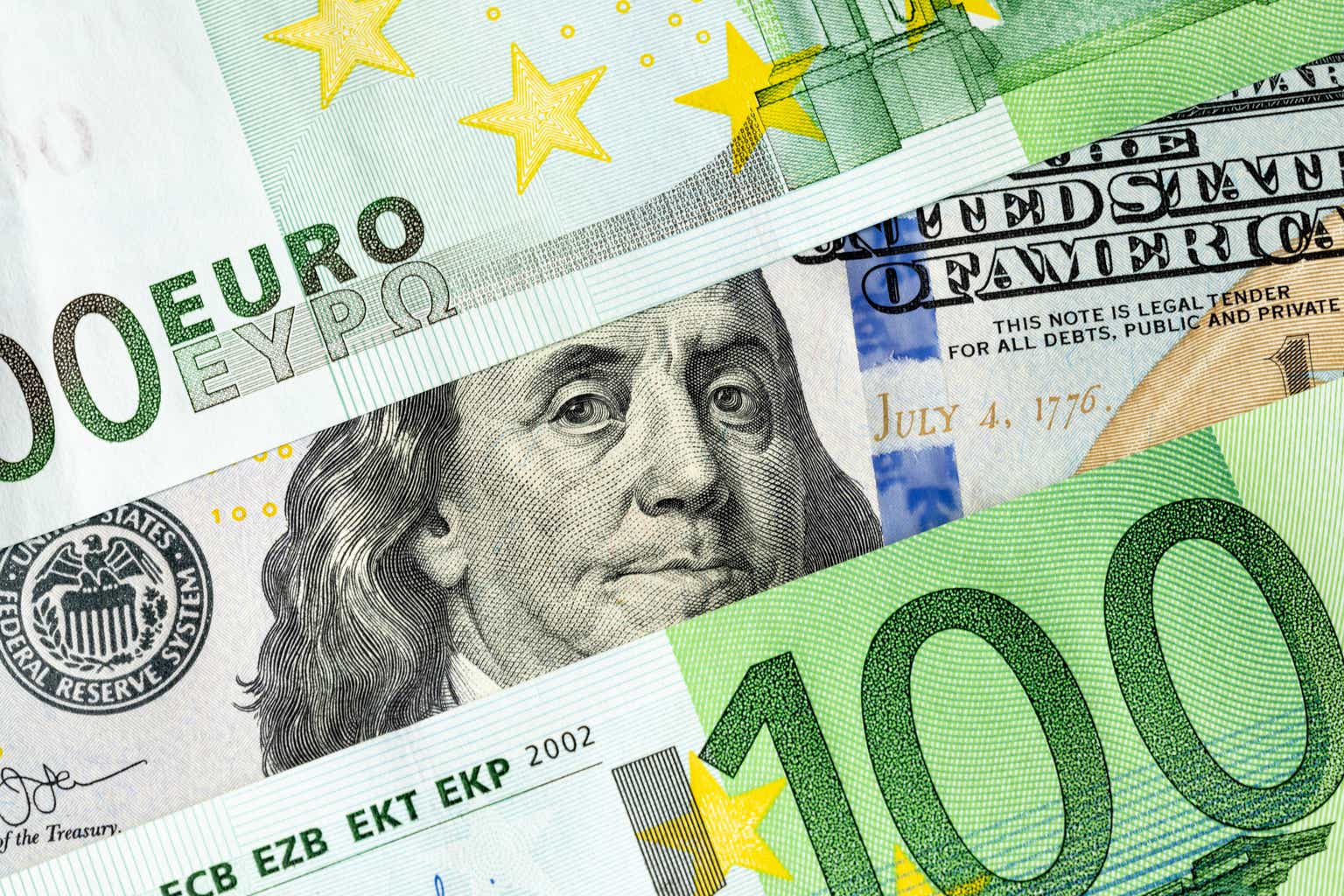By Fawad Razaqzada
The EUR/USD was up for the third consecutive day despite the release of even more disappointing Eurozone data.
And unless it finishes today’s session back below 1.0570, some 100 pips from the current levels, the EUR/USD would also finish the month on a high, preventing a hat trick of negative months. So, has the EUR/USD bottomed out?
Euro Strong Across the Board
Notably, the euro was also higher on the month against nearly all her major rivals, including the GBP, JPY, and CAD, as well as the antipodean and Scandinavian currencies.
The EUR/GBP was on course to finish higher for the second month, while the EUR/JPY had crossed the 160.00 handle for the first time since August 2008 following the BoJ’s slight tweak of its policy overnight in a decision that left markets disappointed.
The only exception has been the EUR/CHF, which was still negative on the month at the time of writing. But even this FX cross has been showing relative strength in the last couple of weeks.
In other words, the euro has been showing surprising resilience in the face of all the doom and gloom about the eurozone economy and ongoing geopolitical risks. What doesn’t break you makes you stronger. When markets rise on bad news, one can only assume that most of the pessimism is already priced in.
Indeed, today’s publication of eurozone data showed the single currency bloc contracted in Q3 while inflation slowed down further in October, with both macro pointers coming in weaker than expected. German retail sales also disappointed expectations.
- CPI Inflation YoY (Oct): 2.9%, down from 4.3% (3.1% exp)
- Core Inflation YoY (Oct): 4.2%, down from 4.5% (4.2% exp)
- Eurozone Q3 GDP: -0.1% vs. 0.1% in Q2 (0% exp)
- German Retail Sales -0.8% m/m vs. +0.5% expected and -1.1% last
Dollar Shows Signs of Weakness Ahead of a Busy Week
Part of the reason behind the EUR/USD’s recent strength can be explained away by the dollar showing signs of fatigue against most major currencies (except the JPY perhaps).
After topping out at $1.1275 in July, the euro has shed over 8,00 pips at its lowest point in early October of just below 1.0450. That 7% decline was mainly in response to the sharp repricing of “higher for longer” US interest rates narrative, and the further deterioration we saw in Eurozone data.
But the further resilience of US data we have seen over the past couple of weeks hasn’t led to any further appreciation in interest rate expectations, keeping the dollar in consolidation mode.
The EUR/USD has managed to cling on to key support in the 1.05-1.06 area as a result. So, there is a possibility we may see some strength come back into the EUR/USD, especially if this week’s US data turns out to be weaker than expected.
FOMC is likely to signal high rates will stay for a long time
The Fed has kept the door to one more rate hike open. But the market seems convinced there will be no more hikes, certainly not at Wednesday’s meeting. The probability of a hike in the next meeting in December was around 20% last week.
Those odds could increase or decrease sharply depending on how hawkish or otherwise the Fed is going to be this week. But a lot will also depend on incoming data. We have seen plenty of forecasting-beating US data of late.
Last week saw the UoM’s consumer sentiment, pending and new home sales, GDP, and both manufacturing and services PMIs all come in ahead of expectations. The week before, it was retail sales, industrial production, and jobless claims data that topped expectations.
So, the US economy is showing continued resilience in the face of high interest rates, putting the Fed in a slightly difficult position as to whether it should tighten its belt even further, or just keep rates at these current levels for a longer-than-expected period.
A growing number of analysts and economists seem to agree with the latter approach. Let’s see if this is something that the Fed alludes to at this meeting.
One reason why the Fed is unlikely to raise rates again is the recent rise in long-term bond yields, which effectively is equivalent to a couple of additional rate hikes. This is all in the price.
Forward-looking investors are perhaps thinking that if interest rates stay high, the eventual rate-cutting cycle that will inevitably follow will be more pronounced than would otherwise be the case. That may explain why the EUR/USD is showing some signs of life.
But let’s not get too ahead of ourselves yet and a lot can change both in the Eurozone and the US in the next couple of months. Let’s see whether and how the trend of the US data will evolve, starting with the monthly jobs report that is due on the economic calendar on Friday.
US NFP and ISM Services PMI Among Key US Data Highlights
The “higher for longer” narrative will be put to the test again later in the week with Friday’s release of the October US jobs report and the ISM services PMI data that would be released later in the day.
With the Fed meeting taking place in mid-week, the US dollar should be in for a roller-coaster ride. But with the dollar moving sharply higher in the last three months or so, most of the positivity may be priced in.
For the dollar to accelerate from here, it will take a lot more effort. Put another way, if upcoming US data were to disappoint, the US dollar’s downside reaction may well be more pronounced than would otherwise be the case.
EUR/USD Technical Analysis

Source: TradingView.com
Let’s see if this week’s key macro events from the US will change the direction of the trend again. But if we put our trust in technical analysis alone, then one can argue the EUR/USD has potentially bottomed out in light of the recent price action.
That’s because the EUR/USD has broken its bearish trend line that had been in place since July, when the dollar bottomed out.
This break of the trend line and the fact that rates have moved above the short-term 21-day exponential moving average means the path of least resistance is no longer to the downside.
What’s more, the EUR/USD looks set to close higher on the month, with other euro crosses also looking strong across the board.
The key level to watch this week is around 1.0635, which was the low in May. We broke below this level in September, and the retest of it from underneath was held twice earlier in the month.
But the EUR/USD is now finding itself above this pivotal level again. If we continue to see acceptance above this level, then look out for a short squeeze rally, while a move back below it would complicate the technical picture again.
Originally published on MoneyShow.com
Editor’s Note: The summary bullets for this article were chosen by Seeking Alpha editors.
Read the full article here






